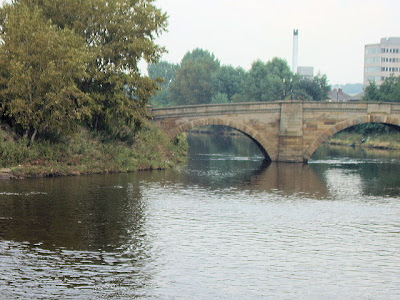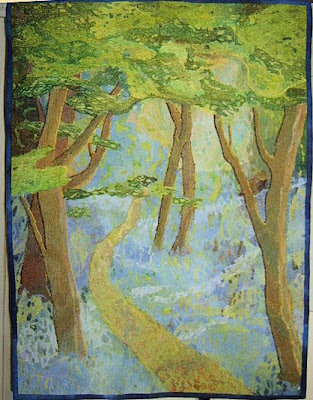
Thursday 25 September 2008
Ah, Sunflower, weary of time

Friday 19 September 2008
Castleford Weir
This week it was the turn of Castleford, a town suffering badly from closures of local industries, most notably pit closures, a place I'd thought of as rather sad and downtrodden. Recently there have been moves to improve the town. Amongst the things that have happened is the building of a magnificent new bridge over Castleford Weir on the River Aire near where it meets the Calder: (an historical sidenote on the two rivers - it used to be said that "Castleford ladies are beautiful and fair. They wash in the Calder and rinse in the Aire")

For once I remembered my camera. The picture above is of what used to be a local mill where flour was ground. The river was in spate (heavy rains in previous weeks) which meant that water was plentiful. Here's the mill-race which once powere the mill:

And here's the old bridge, lower down:

The new bridge is an amzing structure built of wood and very different but equally beautiful. This photograph shows only a part of it and does not really do it justice though it does show the way it curves over the river.

The wires on the sides are thick and tensioned which makes it very safe for children -no danger of falling in. While we were there there were numerous local families enjoying the view. All in all a successful piece of modern design which also has allusions to more traditional design.
Whilst I was there I managed to get some inspirational pictures of water. Here I was really pleased to be able to capture something of the patterns the water makes:

and this one is my favourite: I set out to try to capture the subtlety of the colours and the contrast between the smoothness of the water above the weir and the turbulence below, and actually managed both!

Sunday 14 September 2008
Blog Award

Saturday 13 September 2008
Belatedly - Festival of Quilts
Apologies for the delay in reporting back: I returned with a cold which became a nasty bout of bronchitis followed by a further bout of general fatigue followed by a period of utter laziness!
I actually treated myself to the whole week in Birmingham, which seemed like a good idea at the time. The first three days I spent in a masterclass with Susan Brandeis about developing creative potential and designing meaningful quilts. If you ever get the chance of a class with Susan, seize it with both hands. It came at absolutely the right time for me and was exactly what I needed since - as my entries for FOQ below will reveal - my work suffers at times from lack of thought: I've tended to go with the flow rather than really thinking about and developing ideas and designs. I'll post later about how this workshop has helped me develop.
One really good thing about the workshop was the group of people I was with: really supportive people producing excellent work - though at times I did feel myself running to catch up! Here we are (minus a couple of people who had to leave early:

By the end of the masterclass I was completely exhausted and, having seen all the amazing quilts (standards have been raised colossally since I last went to a large quilt show), I felt more than a bit apologetic about mine. Still I did promise to put them on my blog and here they
are:

First of all Snakes and Ladders, finished at last. Even though there are things wrong with this I still love it: apart from anything else it's the first quilt I'd started since 2000 when my husband died so it's great to have it finished.
The second is based on pebbles and rockpools, made of silk, satin, silk organza and cotton jersey plus silk fibres, hand embroidery and machine quilting:

The third quilt is the one I was really embarrassed by - if I could have taken it down and stuffed it away and hidden it from view I would have done so. I hadn't intended to attempt anything naturalistic but it kept drifting that way - not only that but it wasn't very well designed to start with (shouldn't have skimped on that bit) so that compositionally it is dreadful. On the plus side some of the detail works really well (two of the three judges commented on the painterly use of fabric, and one liked the light in the trees so there's something to build on there).

Must remember next year to only enter things finished before the entry deadline so that I know I'm only presenting my best work to the public!
The remainder of the week was highly enjoyable. Lots of amazing quilts and exhibitions to see (afraid I don't have pictures as I had camera problems), friends old and new to meet and catch up with and went home with lighter pockets but weighed down with supplies.
Oh, and the cats really did seem to miss me - wouldn't let me out of their sight once for three weeks after coming back from the cattery but insisted on following me everywhere - even Bixy made his way up two flights of stairs to find a curling-up spot in the studio.
More catching up soon!